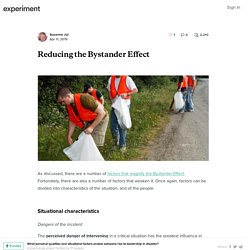

The Bystander Effect Social Experiment. From Empathy to Apathy: The Bystander Effect Revisited - Ruud Hortensius, Beatrice de Gelder, 2018. When people are asked whether they would spontaneously assist a person in an emergency situation, almost everyone will reply positively.

Although we all imagine ourselves heroes, the fact is that many people refrain from helping in real life, especially when we are aware that other people are present at the scene. In the late 1960s, John M. Darley and Bibb Latané (1968) initiated an extensive research program on this so-called “bystander effect.” In their seminal article, they found that any person who was the sole bystander helped, but only 62% of the participants intervened when they were part of a larger group of five bystanders.
Following these first findings, many researchers consistently observed a reduction in helping behavior in the presence of others (Fischer et al., 2011; Latané & Nida, 1981). Neural Mechanisms of Bystander Apathy Can neuroimaging studies inform the investigation of the bystander effect? Fig. 1. Dispositional Influences on Bystander Apathy Fig. 2. Preston, S. Bystander. Diffusion of Responsibility Reduces Sense of Agency and Outcome Monitoring.
The Implicit Bystander Effect. An Example of Diffusion of Responsibility: The Smoke Filled Room Study. Diffusion of Responsibility. Understanding Pluralistic Ignorance in Social Psychology - Psychologenie. Pluralistic Ignorance in the Bystander Effect. An Example of Pluralistic Ignorance. How to Overcome the Bystander Effect. Psychologists have long been interested in exactly why and when we help other people.

There has also been a tremendous amount of interest in the reasons why we sometimes don't help others. The bystander effect is a social phenomenon that occurs when people fail to help those in need due to the presence of other people. In many cases, people feel that since there are other people around, surely someone else will leap into action.1 While the bystander effect can have a negative impact on prosocial behavior, altruism and heroism, researchers have identified a number of different factors that can help people overcome this tendency and increase the likelihood that they will engage in helping behaviors.2 Some of these include: Witnessing Helping Behavior Sometimes just seeing other people doing something kind or helpful makes us more willing to help others.
Imagine that you are walking into a large department store. Being Observant Being Skilled and Knowledgeable Guilt Feeling Good. How to Break the Bystander Effect. They could have left it to someone else. An Army veteran blocked a shooter in Oregon from entering his classroom. Three friends on a high-speed train from Paris to Amsterdam helped stop a gunman wielding an AK-47. This past spring, an Army captain in North Carolina pulled a couple to safety after a fiery car crash. Were these men instinctively courageous, or had they learned to be?
The Army captain (aptly wearing a Captain America T-shirt) credited his military training for knowing what to do and remaining calm. These heroes are dramatic examples. And this conundrum is not limited to thwarting terrorism or physically saving someone. But we often look the other way, like the priest and Levite in the Good Samaritan parable. The Bystander Effect The bystander effect is a phenomenon that occurs when individuals witness someone in trouble, but don’t offer help. Causes of the Bystander Effect Fear and Uncertainty: Sometimes, it’s not easy to tell if intervention is needed. We seek guidance. Reducing the Bystander Effect.
As discussed, there are a number of factors that magnify the Bystander Effect.

Fortunately, there are also a number of factors that weaken it. Once again, factors can be divided into characteristics of the situation, and of the people. Situational characteristics Dangers of the incident. What is the Bystander Effect and How Can We Overcome it? You may think that you are more likely to receive life-saving care if you experience a Sudden Cardiac Arrest (SCA) in a crowd or busy area – but the opposite is actually true.

This is due to the bystander effect; a natural phenomenon where the greater the number of bystanders, the less likely any individual is going to act to provide help. It’s a complex phenomenon but one we actively need to combat in order to support people in distress. Understanding the Bystander Effect When an emergency situation occurs, people are more likely to take action if there are fewer people around. This reaction takes place for a number of reasons, including assumptions that: Someone else is already doing somethingSomeone else is more qualified to assistYou may hurt the person further rather than helping if you try assistYou may be punished (sued or held responsible) if you try to help and fail.
Positive Actions to Prevent Bullying (Avoid Bystander Effects) 5 Steps Intervention. 3 Steps to Intervene. Bystander Intervention Tips and Strategies. Appeal to Bystander Interventions: A Normative Approach to Health.